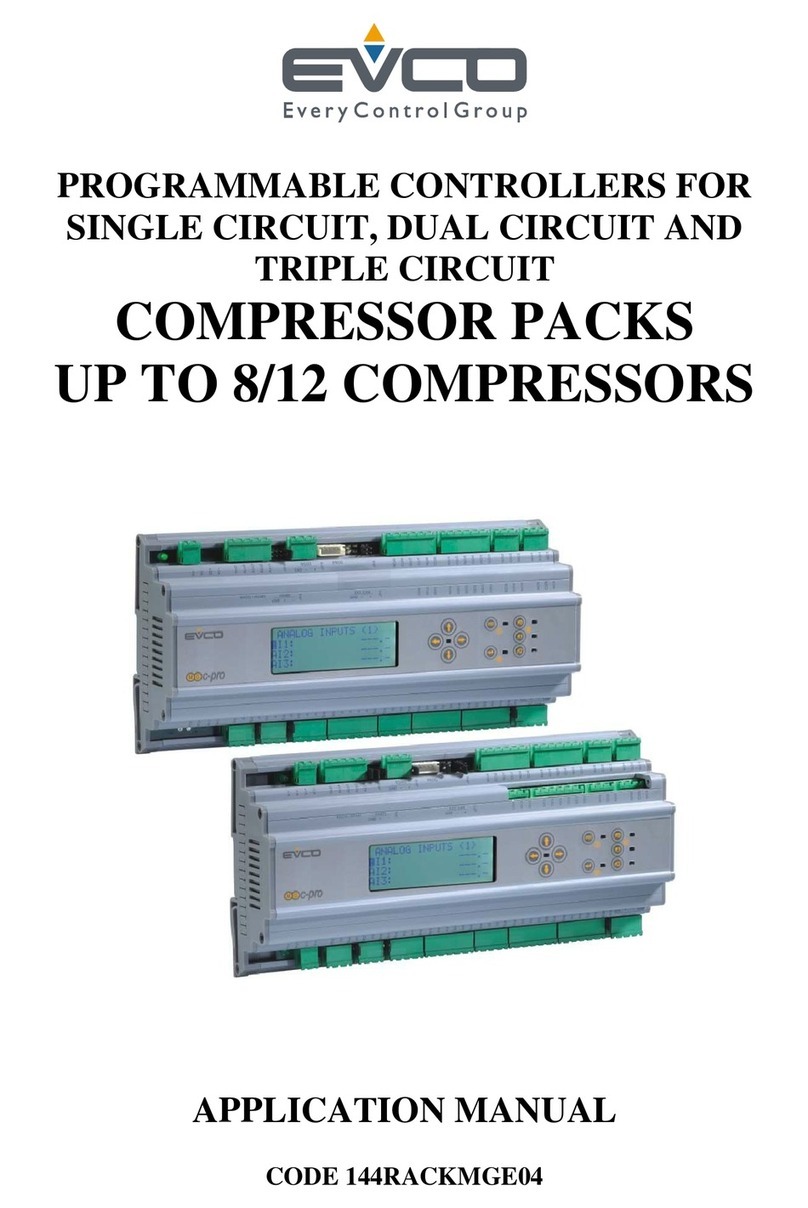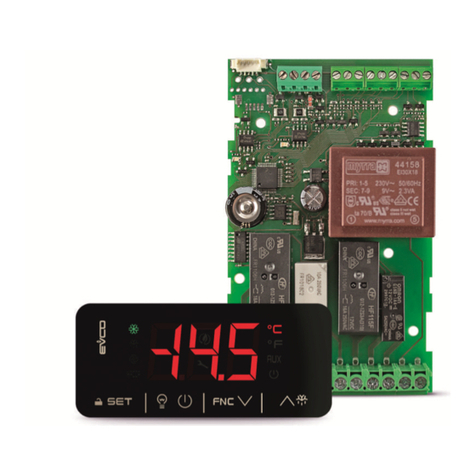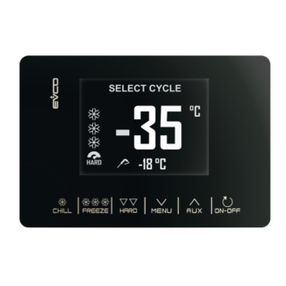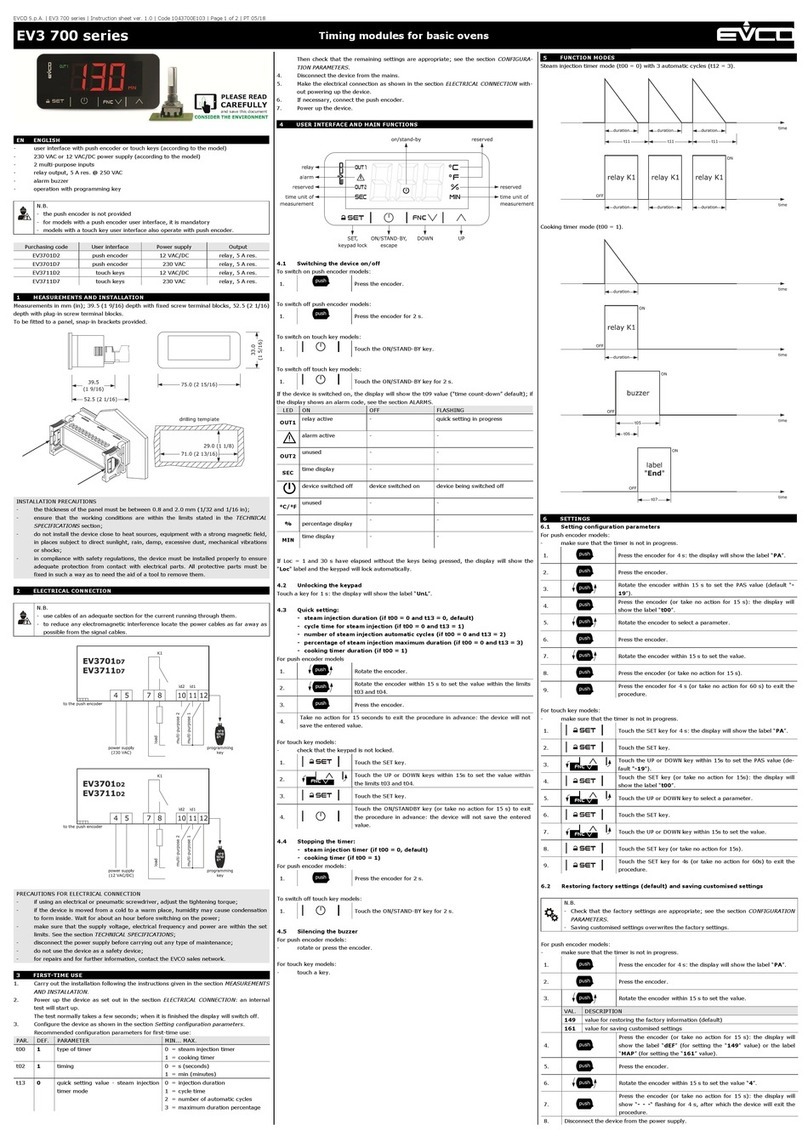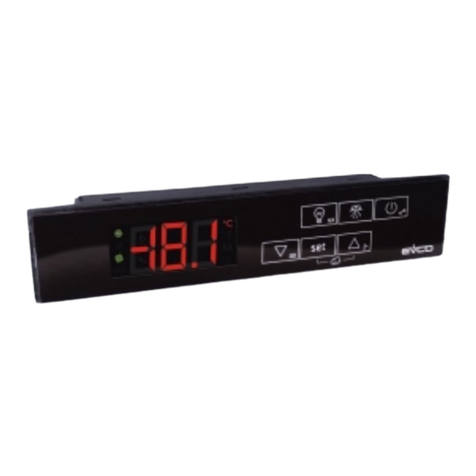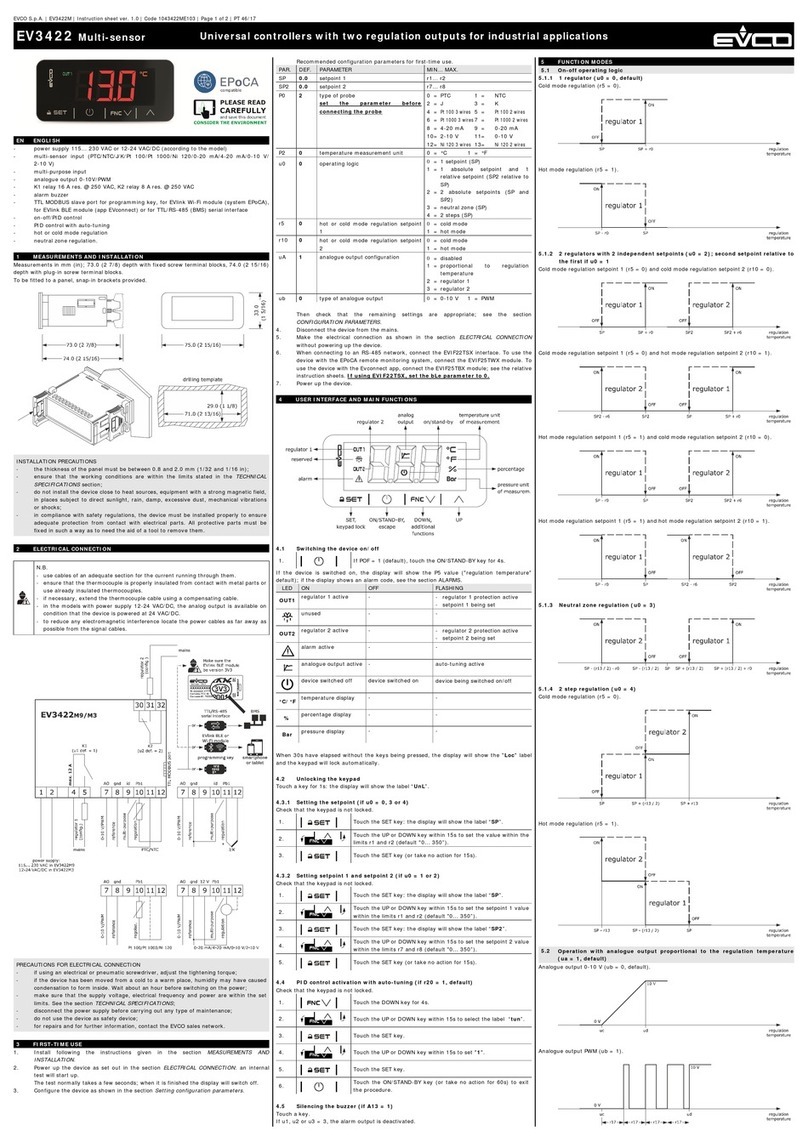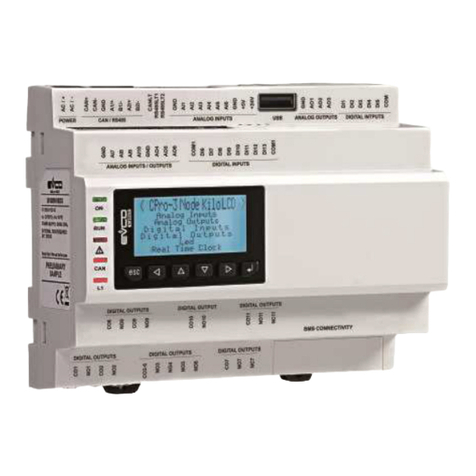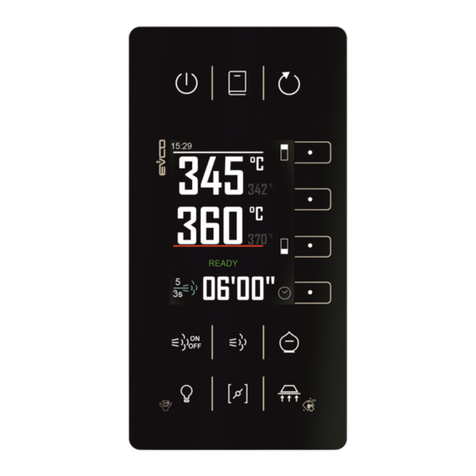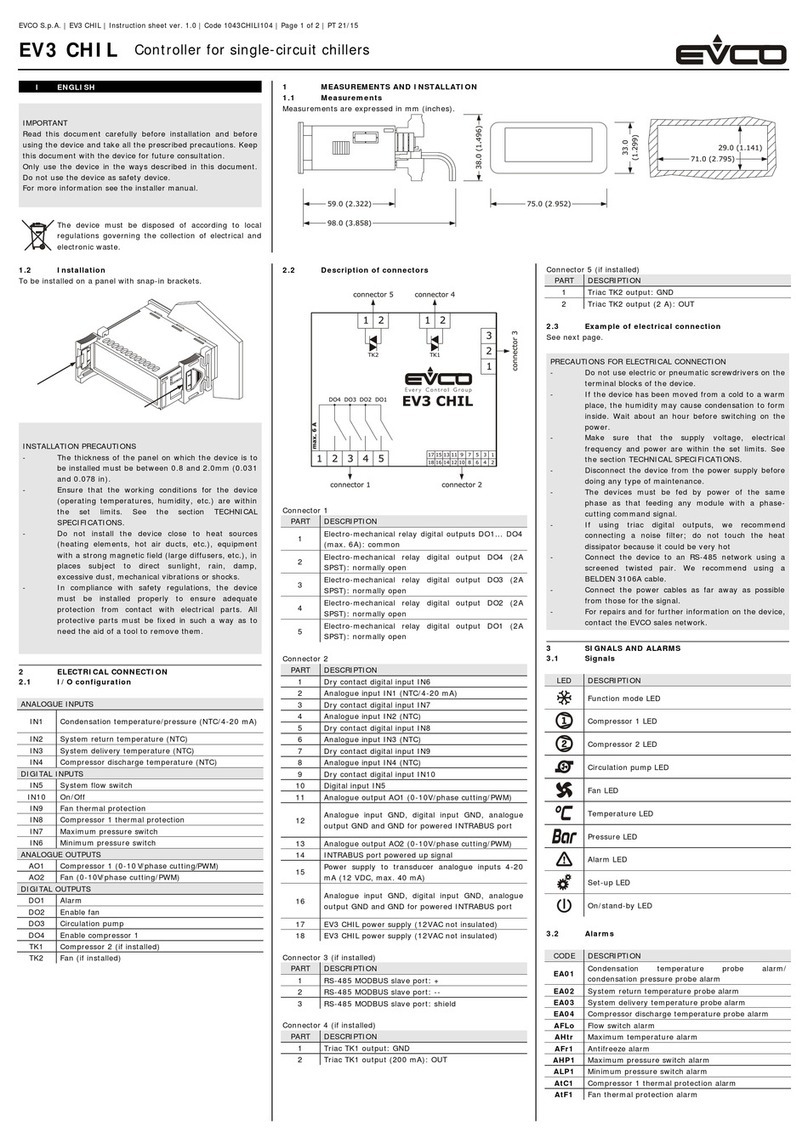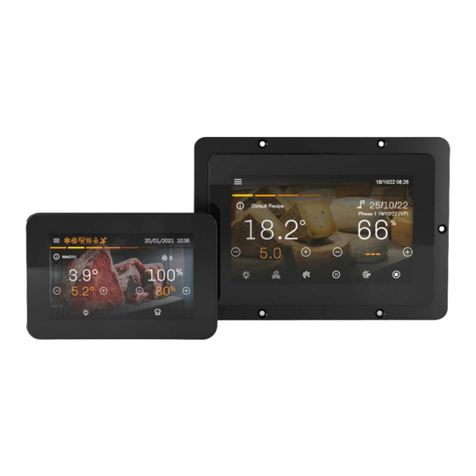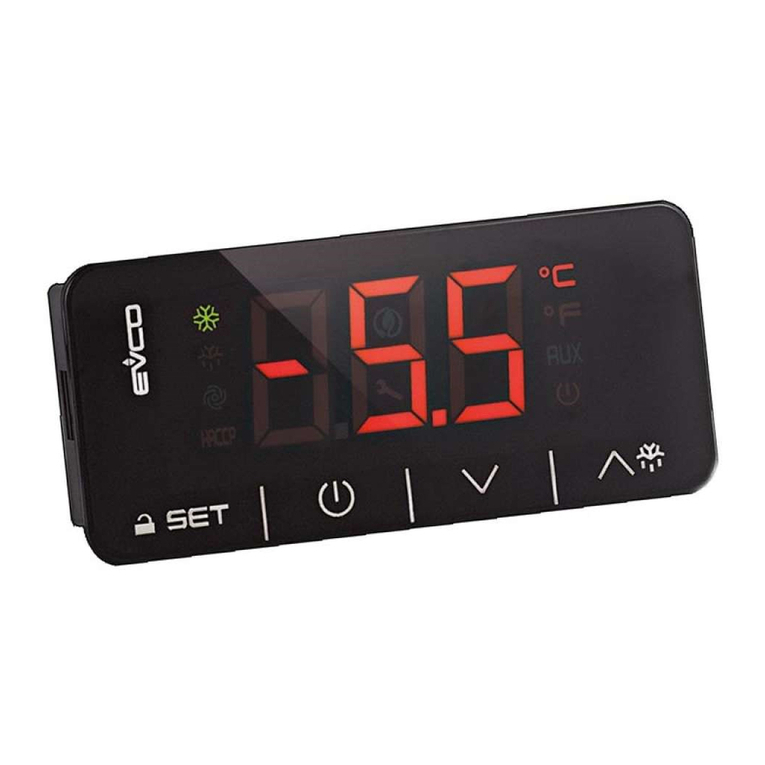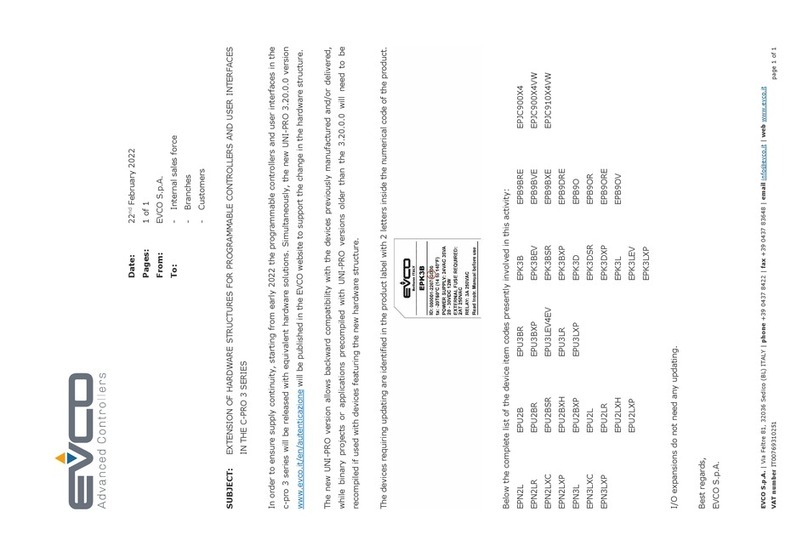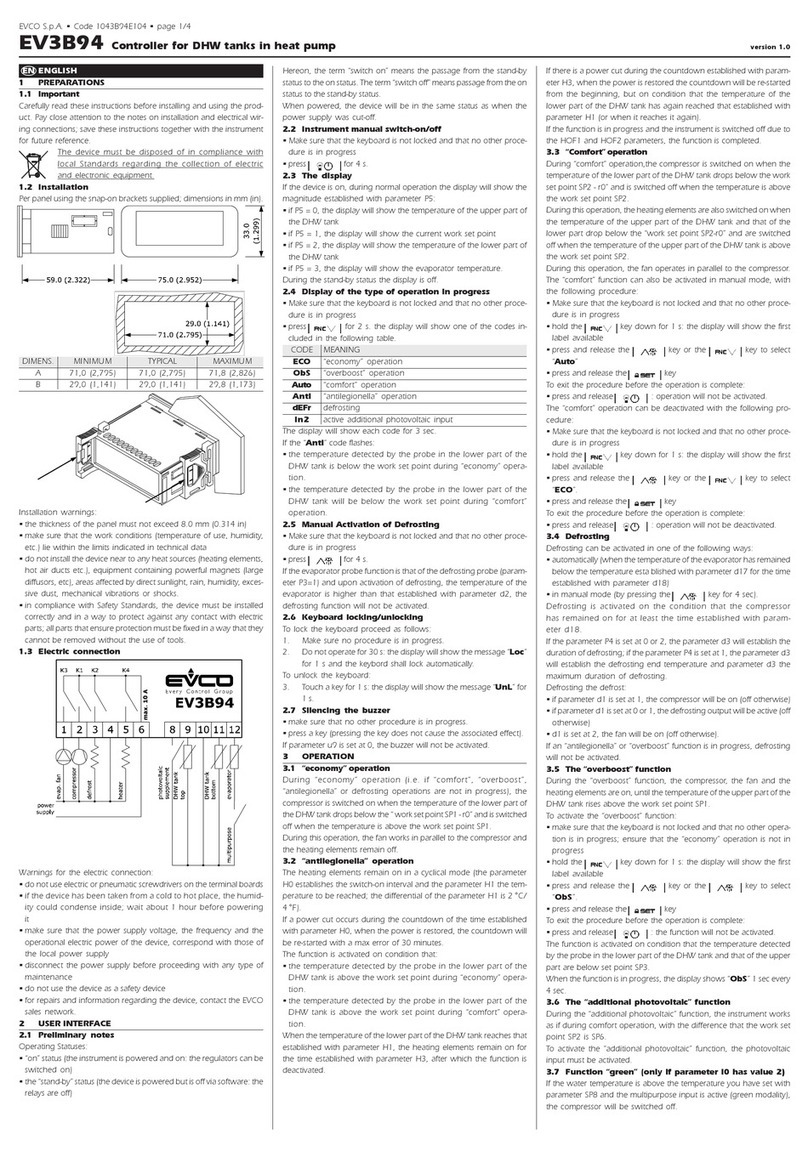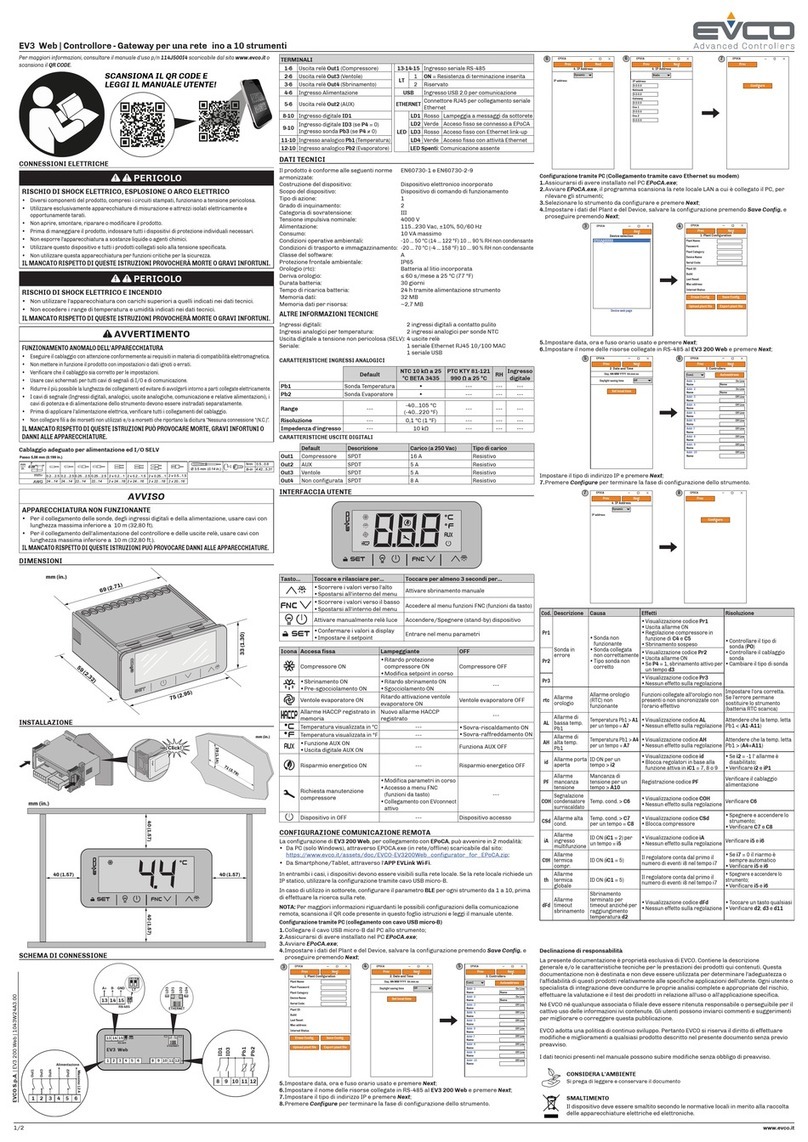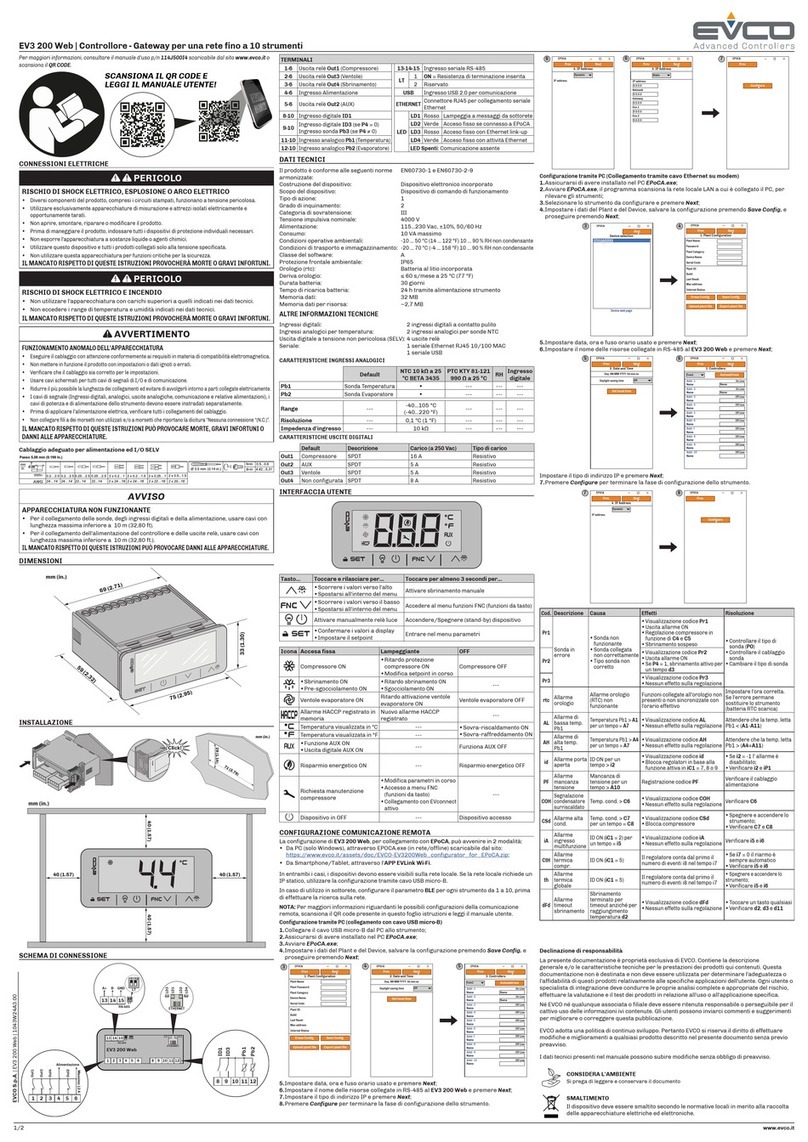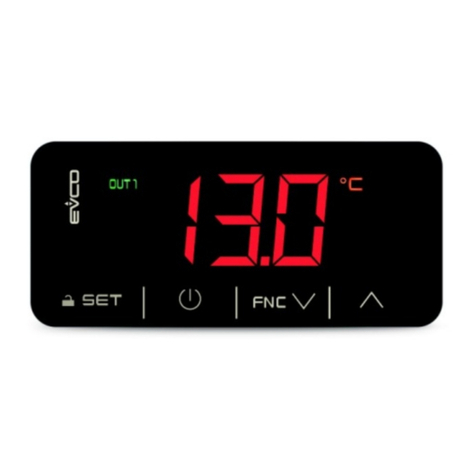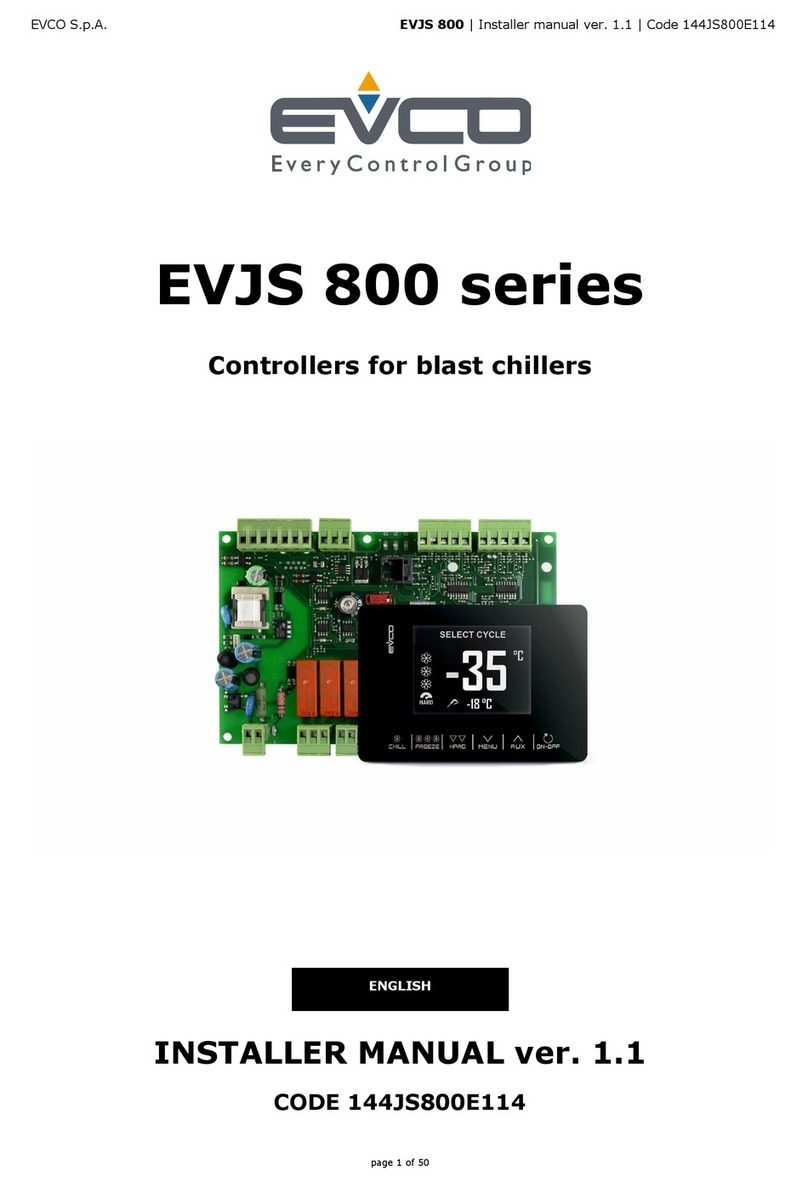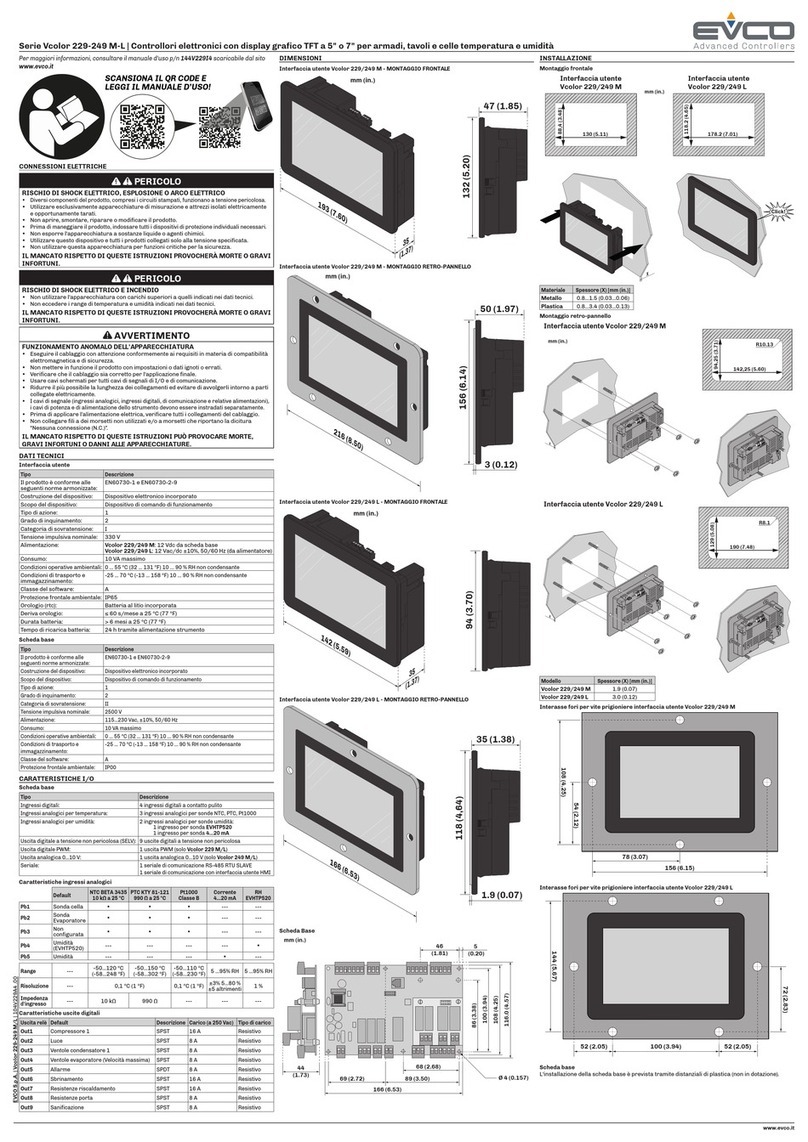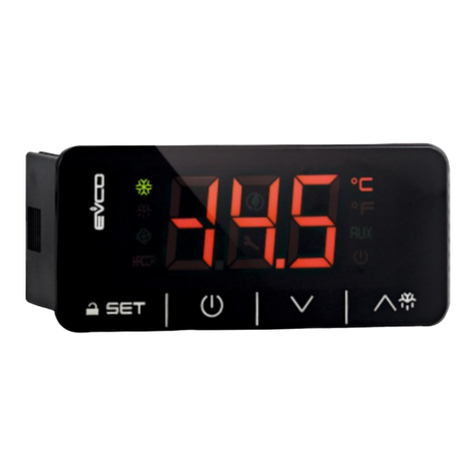
Evco S.p.A. • Code 104F205E20 • page 2/8
If the function of the evaporator probe is that of defrosting probe
(parameter P3 = 1) and on activation of defrosting the temperature of
the evaporator is above that established with parameter d2, defrosting
will not be activated.
4.8 Functioning due to low or high relative humidity
percentage (only if parameter F0 is set at 5)
During functioning due to low relative humidity percentage, the
evaporator fan will be switched-on if the compressor is on and is
switched-on cyclically if the compressor is off (parameter F4 establishes
the duration of evaporator fan switch-off and parameter F5 that
regarding switch-on).
During functioning due to the high relative humidity percentage, the
evaporator fan is always on.
4.8.1 Activation of the functioning due to low or high
relative humidity percentage (only if parameter
F0 is set at 5)
• make sure that the keyboard is not locked and that no procedure is
in progress
• press and hold the and key for 4 s: the display will show “rhL”
(functioning due to low relative humidity percentage) or “rhH”
(functioning due to high relative humidity percentage) for 10 s.
To restore normal display in advance:
• press a key.
It is also possible to activate functioning due to low or high relative
humidity percentage using parameter F6.
If parameter F0 is not set at 5, pressing the and key will cause the
“- - - -“ indication to be displayed for 1 s.
4.8.2 Learning of the type of functioning in progress
(due to low or high relative humidity percentage
only if parameter F0 is set at 5)
• make sure no procedure is in progress
• press and release the key and the key: the display will show
“rhL” (functioning due to low relative humidity percentage) or “rhH”
(functioning due to high relative humidity percentage) for 10 s.
To restore normal display in advance:
• press a key.
If parameter F0 is not set at 5, pressing the and key will cause:
• the display of the “- - - -“ indication for 1 s if the keyboard is not locked
• the display of the “Loc” label for 1 s if the keyboard is locked.
4.9 Switch-on/off of the cabinet light in manual mode
(only if parameter u1 and/or parameter u11 is set
at 0)
• make sure no procedure is in progress
• press and release the key: the light LED will switch-on/off.
Using the door micro switch input, the cabinet light can also be
switched-on/off in remote mode; see also parameter u2.
If parameter u1 is set at 0 (i.e. the utility managed by the fourth output
is the cabinet light) and parameter u11 is set at 2 (i.e. the utility managed
by the fifth output is the auxiliary output), holding the key down
for 2 s will cause the switch-on/off of the multipurpose LED and of the
auxiliary output.
4.10 Switch-on of the demisting heaters (only if
parameter u1 and/or parameter u11 is set at 1)
• make sure that the instrument is on and that no procedure is in
progress
• hold the key down for 2 s: the multipurpose LED will switch-on
and the heaters will be switched on, both for the time established
with parameter u6.
The demisting heaters cannot be switched off in manual mode (i.e.
before the time established with parameter u6 has passed).
4.11 Switch-on/off of the auxiliary output in manual
mode (only if parameter u1 and/or parameter u11
is set at 2)
• make sure that the keyboard is not locked and that no procedure is
in progress
• press and release the key.
The multipurpose input can also be used to switch the auxiliary output
on/off in remote mode.
If parameter u1 is set at 2 (i.e. the utility managed by the fourth output
is the auxiliary output) and parameter u11 is set at 0 (i.e. the utility
managed by the fifth output is the cabinet light), holding the key
down for 2 s will cause the switch-on/off of the cabinet light LED and
of the cabinet light.
If the auxiliary output has been switched on in manual mode, sit can
only be switched off in the same way (also, if the auxiliary output has
been switched off in remote mode, it can only be switched off in the
same way); see also parameter u2.
4.12 Energy Saving
During the Energy Saving function, the work set-point is increased of
the temperature established with parameter r4 and the evaporator fan
is switched on cyclically, on condition that the parameter F0 is set at 1
or 2 (parameter F13 establishes the duration of fan switch-off and
parameter F14 that regarding switch-on).
When the time established with parameter i10 has passed without
activation of the door micro switch (after the cabinet temperature has
reached the work set-point) the Energy Saving function is activated
automatically (until the input is activated again).
4.12.1 Activation/deactivation of the Energy Saving
function with effect only on the compressor
The multipurpose input can also be used to switch the Energy Saving
function on/off in remote mode.
4.13 Lock/unlock of the keyboard
To lock the keyboard:
• make sure no procedure is in progress
• press and hold the and key for 1 s: the display will show “Loc”
for 1 s.
If the keyboard is locked, the following is not allowed:
• to switch the instrument on/off in manual mode
• to display the evaporator temperature (with the procedure indicated
in paragraph 4.4)
• to display the condenser temperature (with the procedure indicated
in paragraph 4.5)
• activated/deactivate the Overcooling function
• activate defrosting in manual mode
•to activate functioning due to high or low relative humidity
percentage and to learn the type of functioning
• to switch the auxiliary output on/off in manual mode
• to display the information regarding the HACCP alarms
• to delete the list of HACCP alarms
•to modify the work set-point (with the procedure indicated in
paragraph 5.1)
• to display the compressor functioning hours
• to cancel the compressor functioning hours.
These operations cause the “Loc” label to be displayed for 1 s.
To unlock the keyboard:
• press and hold the and key for 1 s: the display will show
“UnL” for 1 s.
4.14 Silencing the buzzer
• make sure no procedure is in progress
• press a key (the first time the key is pressed does not cause the associated
effect).
If parameter u1 and/or parameter u11 is set at 3 and parameter u4 is
set at 1, pressing the key will also cause the alarm output to be
deactivated.
If parameter u9 is set at 0, the buzzer will not be enabled.
5 SETTINGS
5.1 Setting the work set-point
• make sure that the keyboard is not locked and that no procedure is
in progress
• press and release the key: the compressor LED will flash
• press and release the key or the key within 15 s; see also
parameters r1, r2 and r3
• press and release the key or do not operate for 15 s the compressor
LED will switch-off, after which the instrument will exit the procedure.
To exit the procedure in advance:
• do not operate for 15 s (any modifications will be saved).
It is also possible to set the work set-point via parameter SP.
5.2 Setting the configuration parameters
To access the procedure:
• make sure no procedure is in progress
• press and hold the and key for 4 s: the display will show “PA”
• press and release the key
• press and release the key or the key within 15 s. to set “-19”
• press and release the key or do not operate for 15 s
• press and hold the and key for 4 s: the display will show “SP”.
To select a parameter:
• press and release the key and the key.
To modify a parameter:
• press and release the key
• press and release the key or the key within 15 s.
• press and release the key or do not operate for 15 s.
To exit the procedure:
• press and hold the key and the key for 4 s or do not operate
for 60 s (any modifications will be saved).
Cut off the power supply to the instrument after modification
of the parameters.
5.3 Restoring factory settings
To access the procedure:
• make sure no procedure is in progress
• press and hold the and key for 4 s: the display will show “PA”
• press and release the key
• press and release the key or the key within 15 s. to set “149”
• press and release the key or do not operate for 15 s
• press and hold the and key for 4 s: the display will show “dEF”
• press and release the key
• press and release the key or the key within 15 s. to set “1”
• press and release the key or do not operate for 15 s the display
will show flashing “dEF” for 4 s, after which the instrument will exit
the procedure
• cut the instrument power supply off.
To exit the procedure in advance:
• press and hold the key and the key for 4 s during the procedure
(i.e. before setting “1”: restore will not be performed).
Check that the factory settings are appropriate (see
chapter 12).
6 HACCP FUNCTION
6.1 Preliminary considerations
The instrument is able to store up to 3 HACCP alarms.
The instrument provides the following inoformation:
• the critical value
• the alarm duration (from 1 min to 99 hours and 59 min, partial if the
alarm is in progress).
CODE ALARM TYPE (CRITICAL VALUE)
AL minimum temperature alarm (the minium cell tempera-
ture during any alarm of this type)
AH maximum temperature alarm (the maximum cell tempera-
ture during any alarm of this type)
id door microswitch input alarm (the maximum cell tempera-
ture during any alarm of this type; see also parameter i4
Important Notes:
•the codes are displayed in the order shown in the table
•the instrument stores the minimum and maximum tem-
perature alarms provided the temperature associated
with the alarm is that of the cell (parameter A0 = 0)
•the instrument updates the information regarding the
the alarm provided the critical value of the new alarm is
more critical than that stored alarm or provided the infor-
mation has already been displayed.
•if the instrument is switched off, no alarms will be stored.
When the problem that caused the alarm disappears, the display is
restored to normal operation.
The HACCP LED provides information regarding the HACCP alarm
storage status; see paragraph 8.1.
6.2 Display of the information regarding the HACCP
alarms
To start the procedure:
• ensure that the keyboard is not locked and that no other procedure
is in progress
• hold down the key for 1 sec: the display will show the first label
available
• press and release the or key to select “LS”
• press and release the key: the display will show one of the codes
included in the table in paragraph 6.1.
To select an alarm:
• press and release the or key (to select, for example, “AH”).
To view the information about the alarm:
• press and release the key: the HACCP LED will stop flashing and
remain permanently on and the display will show the following
sequence of information (for example):
INFO. MEANING
8.0 the critical value is 8.0 °C/8 °F
dur the display is about to show the duration of the alarm
h01 the alarm has been going off for 1 hour (data continues ...)
n15 the alarm lasted for 1 hour and 15 min
AH the alarm selected
The display shows each message for 1 sec.
To exit the sequence of information:
• press and release the key: the display will show the alarm selected
(in the example “AH”).
To exit the procedure:
• exit the sequence of information
• press and release the or key until the display shows the cell
temperature and then do not operate for 60 sec.
Alternatively:
• exit the sequence of information.
• press and release the key.
If the instrument does not have any alarms stored, the label “LS” will
not be displayed.
6.3 Deletion of the list of HACCP alarms
• make sure that the keyboard is not locked and that no procedure is
in progress
• hold the key down for 1 s: the display will show the first label
available
• press and release the key or the key to select “rLS”
• press and release the key
• press and release the key or the key within 15 s. to set “149”
• press and release the key or do not operate for 15 s the display
will show flashing “- - - -” for 4 s. and the HACCP LED will switch-off,
after which the instrument will exit the procedure.
If the instrument has no alarm in the memory, the “rLS” label will not
be displayed.
7 COUNTING THE COMPRESSOR FUNCTIONING
HOURS
7.1 Preliminary considerations
The instrument can memorise up to 9.999 compressor functioning
hours, after which the number “9999” flashes.
7.2 Display of the compressor functioning hours
• make sure that the keyboard is not locked and that no procedure is
in progress
• hold the key down for 1 s: the display will show the first label
available
• press and release the key or the key to select “CH”
• press and release the key.
To exit the procedure:
• press and release the key or do not operate for 60 s
• press and release the key or the key until the display shows the
cabinet temperature or do not operate for 60 s.
Alternatively:
• press and release the key.
7.3 Deletion of the compressor functioning hours
• make sure that the keyboard is not locked and that no procedure is
in progress
• hold the key down for 1 s: the display will show the first label
available
• press and release the key or the key to select “rCH”
